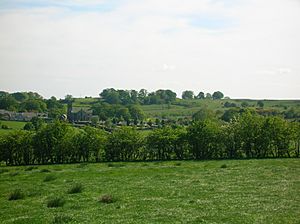Thurgartstone facts for kids
The Thurgartstone or Ogrestone is a very large stone found near Dunlop in East Ayrshire, Scotland. It's a special type of rock called a "glacial erratic." This means it was carried here by a huge glacier long ago. The Thurgartstone sits in a field at Brandleside Farm. People think it used to be a "rocking stone," meaning it could wobble. But now, it's stuck in place because of soil that has built up around it.
Contents
What's in a Name?
The Thurgartstone has many different names! Some of them are Ogrestone, Thorgatstane, and the Ogre's Stone. In modern English, we usually call it the Thurgartstone or Ogrestone.
One idea is that its name comes from "Thor's Great Stone." Thor was a powerful god in old Norse stories. Another idea is that it means "Thou Great Stone" or just "grit stane," which means "great stone."
The name "Ogre's Stone" might hint at an old story or legend that people have forgotten. Some names might even be mistakes from old maps! Another idea is that the name comes from "Tagairtstane," which means "the priest's stone."
Some people think "Ogrestane" might be linked to an old Scandinavian name, "Holger." This could mean that the area around the stone, called Brandleside, also has Scandinavian roots.
Long ago, people might have used the stone as a special altar for religious ceremonies. They might have even used it for cremations. Nearby, there are places called Chapel Crags and a holy well. People believe priests lived there and used the well for healing. Later, Christian monks took over the well and called it St Mary's Well.
Where is the Thurgartstone?
The Thurgartstone is located near the village of Dunlop. It's found in the Black Burn Valley, close to Lugton Road. You can easily spot it in the middle of a field near Brandleside Farm.
From the stone, you can see Dunlop or Boarland Hill. This hill was once home to Dunlop Castle. The stone itself is in a sheltered spot. There is also plenty of running water nearby. Over many years, soil has built up around the stone, hiding some of its size.
What Does the Stone Look Like?
The Thurgartstone is a "glacial erratic stone." This means it's a rock that was moved a long distance by a glacier. It is made of a type of rock called blue augitic porphyrite. This rock is different from the natural rocks found in the area.
The Thurgartstone is very heavy, weighing about 25 tons! The part of the stone that you can see above the ground is about twelve feet long and eight feet wide. It is located near where an old chapel, St Mary's Chapel, used to stand. This site is now protected by Historic Scotland.
The Old Chapel and Saint Mary's Well
There might have been a religious community near the Thurgartstone. This community was linked to a chapel built in the 1100s. This chapel was dedicated to Saint Mary. Monks from Kilwinning Abbey built the chapel. They made sure it had enough money to support a chaplain.
The chapel was built to replace an even older church. This older church was meant to stop the pagan practices around the Thurgartstone. The history of this place is similar to another site called Chapel Hill at Chapeltoun.
There were steps cut into the rock that led to the monks' cemetery. The chapel and graveyard are no longer visible today. The chapel ruins were last seen around 1824 and were removed in 1835. It stood on a rock next to the Black Burn.
There is also a holy well in the field near the burn. New buildings called "Marys Chapel" are built on the original chapel's foundations. Chapelhouse Farm nearby was once called Brandlecraig. The well water came from the bottom of the crags. When the road was built, the well was covered. But its water still flowed through a pipe to a trough.
Chapelhouse Farm and the St Mary's houses used to get their water from this well. It always had a lot of water. Even in 1972, water from the well was still used for baptisms at Dunlop Church. Some old stone pieces from St Mary's Chapel were found and are now kept at North Borland Farm.
Old Beliefs About the Stone
The Thurgartstone has a long history linked to old pagan rituals. Even today, some people hold May Day celebrations at the site. Some believe this "Druidical" stone used to be a "rocking stone." It is now firmly stuck in the ground.
Records show that even in the past, some Catholics would crawl on their knees around the stone. They would cry out, "O thou grit stane!" This shows they believed a powerful spirit was present in the Thurgartstone.
Farmers from Brandleside Farm never moved or broke up the stone. This is different from what happened to many other old stones. Their farm lease even said they had to keep their ploughs a certain distance from the Thurgartstone. This was probably because of a legend that pagan burials were around the monument. Another ancient stone, the Dunlop Carlin stone, is on the other side of the village.
People also believed the well near the stone was sacred to the Druids. They thought its water had magical properties.
Images for kids
-
Dunlop Village in the background.










